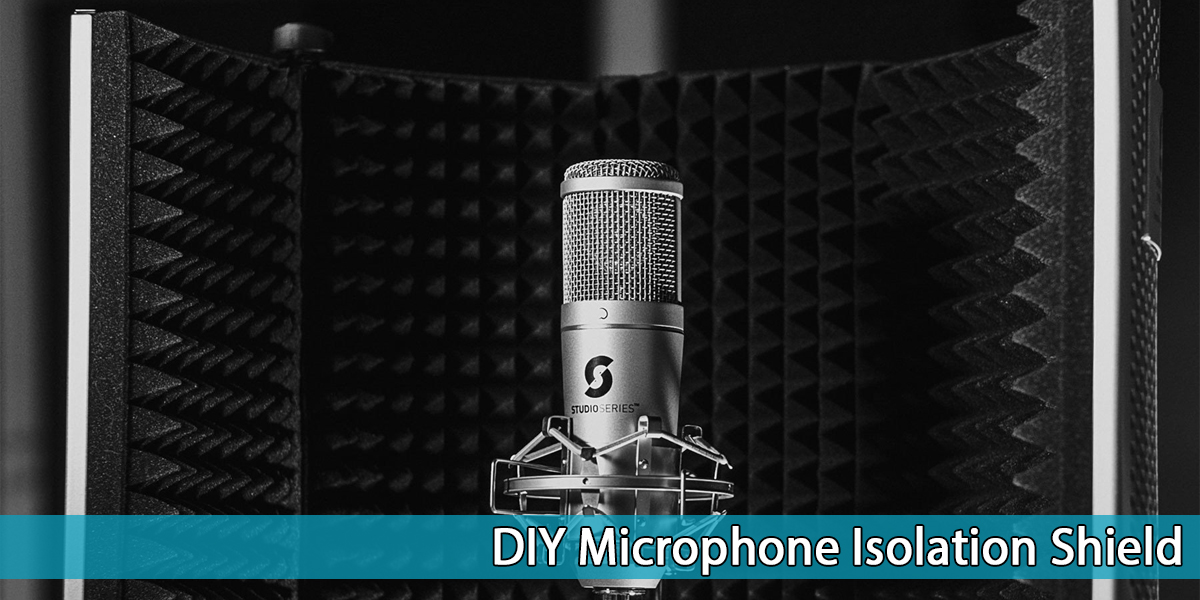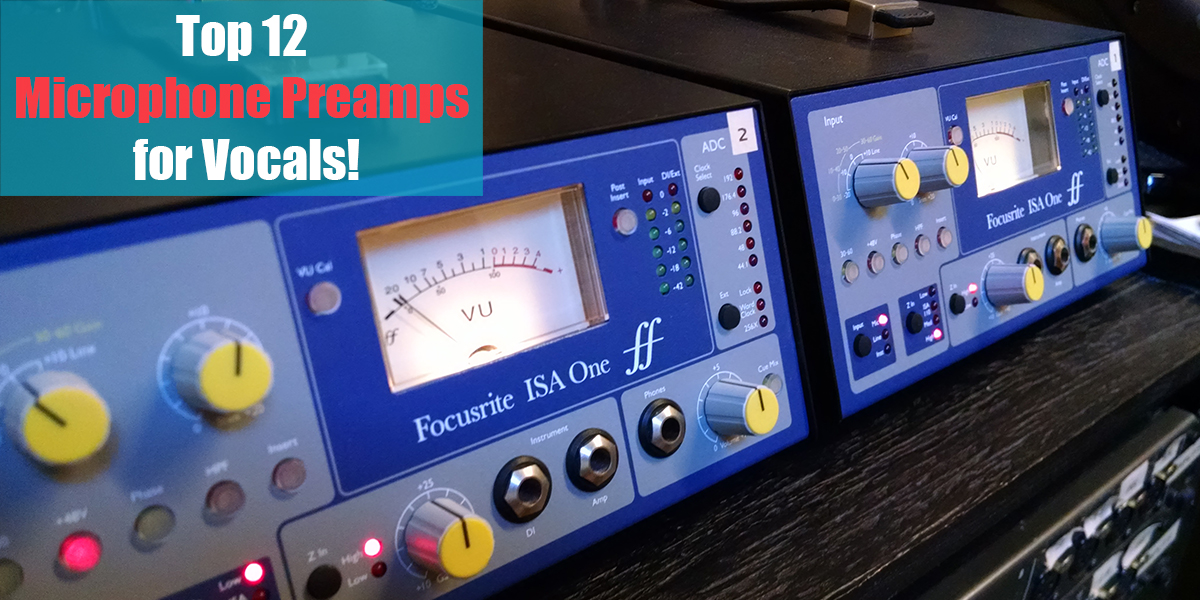Best Small Diaphragm Condenser Microphone
Introduction
Small-diaphragm condenser mics are most commonly used for recording acoustic guitars, hi-hats, harps, drum overheads (but not kick drums), or any instrument with sharp transients (those quick, loud sounds) and rich overtones. Many people have also found them useful in filmmaking.
There are recording techniques that often combine both large and small-diaphragm condensers at the same time, capturing a fuller spectrum of frequencies in the mix.
Compared to large-diaphragm models (1 inch or larger), small-diaphragm condensers (half an inch or less) have lower sensitivity, more self-noise, a broader frequency range, higher sound pressure level (SPL) handling, a wider dynamic range, and are easier to position because of their compact size.
What’s even better is that many of these mics are sold in pairs online, since a lot of people use them to record instruments from different angles for a more effective capture.
We want you to know that we’ll list these best small-diaphragm condenser microphone reviews in no particular order. They’ll be randomized, as we don’t want to rank them from best to worst.
Listed below are our Top 10 Small Diaphragm Condenser Microphones:
1. Shure KSM137 Small-diaphragm Condenser Microphone
The Shure KSM137 is a small diaphragm condenser microphone designed for use in the recording studio. It features a cardioid polar pattern and a frequency response of 20 Hz to 20 kHz, which covers the full range of human hearing. The mic includes a pad with options for -15 dB or -25 dB attenuation, as well as a low-cut filter selectable at either 80 Hz or 115 Hz. It’s a versatile condenser mic suitable for a wide variety of applications.
This cardioid instrument microphone offers excellent sound isolation and outstanding transient response. It features a gold-layered Mylar diaphragm, a transparent preamplifier, a subsonic filter to eliminate low-frequency rumble, and a pad to handle high SPLs.
The KSM137 is an end-address condenser microphone with a fixed cardioid pattern. While it’s designed for studio use, it’s also rugged enough for live performances and can handle extremely high sound pressure levels. With its low self-noise and extended frequency response, it’s ideal for recording instruments.
Versatile, durable, and precise, the KSM137 is an excellent microphone for a wide range of instruments, from percussion to wind, strings to brass, and piano to guitar. The Shure KSM137 is a great choice for an affordable small diaphragm condenser microphone.
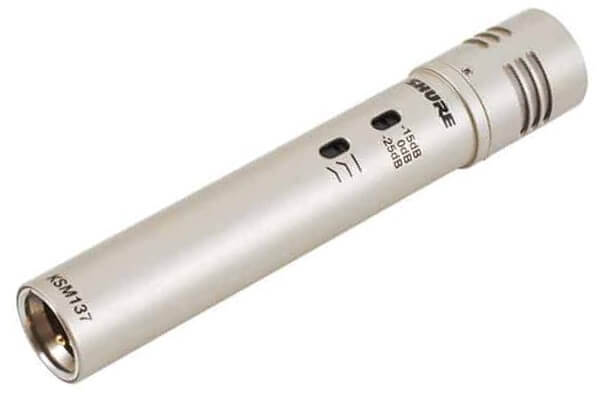
- Polar pattern: cardioid
- Frequency response: 20 Hz – 20 kHz
- Sensitivity: -37 dBV / Pa
- Switchable pad: 0 dB, -15 dB, -25 dB
| IMAGE | PRODUCT | Amazon Store | For US Customers |
For EU Customers |
|---|---|---|---|---|
Shure KSM137 |
2. Rode NT5-S Small-diaphragm Condenser Microphone
Rode NT5 microphones are small but incredibly effective “weapons” to have in your microphone locker. This condenser mic features a cardioid pickup pattern and a frequency range from 20Hz to 20kHz, just like many other standard condensers. What makes these mics fascinating is their especially flat frequency response, with a slight low shelving from 100Hz and a gentle high shelving from 4kHz.
We’re using the NT5, particularly for this purpose, just like many other recording engineers. A new technique we’ve discovered is using these mics to record choirs with the XY mic method. The sound from this position is crystal clear, and you can record even in spaces with a lot of bass frequency reverb—NT5 handles it with ease.
The Rode NT5 Microphone is a stereo pair that helps you make more low-profile recordings. It’s a well-made, essential, and versatile pencil condenser. It features a pair of small diaphragms with low-noise output and a full frequency response.
As you can see, the NT5 is very versatile and can even be used outdoors. In these situations, you can use a pouch that fits over the mic to protect the diaphragm from wind or other unwanted noise.
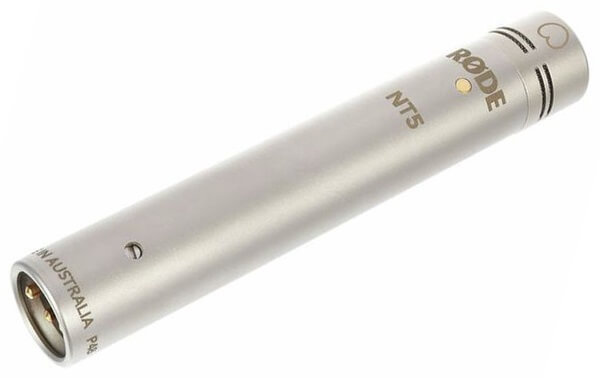
- Polar pattern: cardioid
- Frequency response: 20 Hz – 20 kHz
- Satin nickel finish
- Active electronics: JFET impedance converter
| IMAGE | PRODUCT | Amazon Store | For US Customers |
For EU Customers |
|---|---|---|---|---|
Rode NT5-S |
3. sE Electronics sE8 Small-diaphragm Condenser Microphone
These small-diaphragm, fixed cardioid-pattern microphones are available either as singles or as matched pairs. Unlike some pencil mics, they don’t offer interchangeable capsules. We received a matched pair of sE8s for review, which arrived in a foam-lined aluminum case along with stand clips, a stereo bar, and two foam windscreens for outdoor use.
The capsules are handmade at sE’s own manufacturing facility in Shanghai. According to the spec sheet, the mic features low noise, a clean, natural sound, as well as dual-position pad and low-cut filter switches. To create factory-matched pairs, sE measures a large number of individual microphones and then pairs those with identical characteristics.
Each half-inch capsule uses a three-micron-thick, gold-sputtered diaphragm housed beneath a finely crafted grille, with mesh covering the side vents as well. We’re told the capsule uses a new backplate design to deliver a more consistent off-axis response and a smooth frequency curve.
The spec sheet lists the expected 20Hz–20kHz frequency response, and the response graph shows only the slightest presence boost—starting around 5kHz and peaking just a couple of decibels higher at about 8kHz. With the filters disengaged, the response remains flat down to 30Hz, below which a gentle roll-off begins.
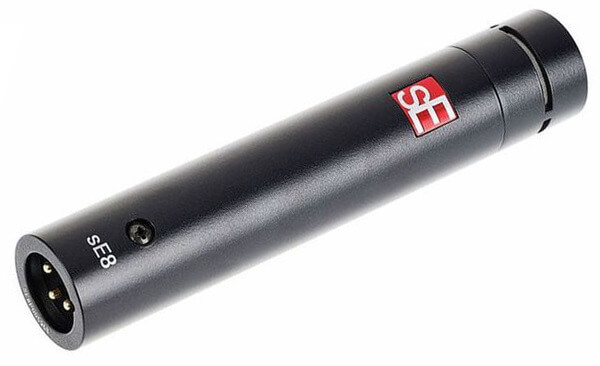
- Polar pattern: cardioid
- Frequency response: 20 Hz – 20 kHz
- Low cut switchable: 80/160 Hz (6 dB / oct.)
- Pad switchable: 0 dB, 10 dB, 20 dB
| IMAGE | PRODUCT | Amazon Store | For US Customers |
For EU Customers |
|---|---|---|---|---|
sE Electronics sE8 |
4. Slate Digital VMS ML-2 Modeling Microphone
The Slate ML-2, released after the Slate ML-1, is a small diaphragm condenser microphone designed for versatility in the studio. It works with software that lets music producers record sources as if they’re using a variety of different microphones. The ML-2 is compatible with the Virtual Microphone System (VMS) and the Virtual Recording Studio (VRS).
This microphone can recreate the sound of an entire collection of instrument mics, including dynamic options like the 57 and 421. It features a dynamic switch that allows it to handle the high sound pressure levels of loud instruments. The ML-2 also offers a low-latency recording experience.
The Slate ML-2 comes with 18 digital mic emulations, including: S-57 Classic, S-57 Modern, S-Custom Snare, S-222, S-121 Dynamic, S-121 Normal, S-421, S-E20, S-Custom Kick, S-12, S-Custom Tom, S-112, S-414 Dynamic, S-414 Normal, S-67, S-47F, S-451, and S-7. The package includes accessories such as a microphone bag, a Virtual Microphone System (VMS) software card, and a microphone clip.
The Slate ML-2 features a linear and flat frequency response similar to its bigger sibling, the ML-1, and includes a side-mounted switch that pads the input circuit and repolarizes the capsule to increase headroom. This makes it suitable for use just like a dynamic mic on drums, guitar cabinets, and more.
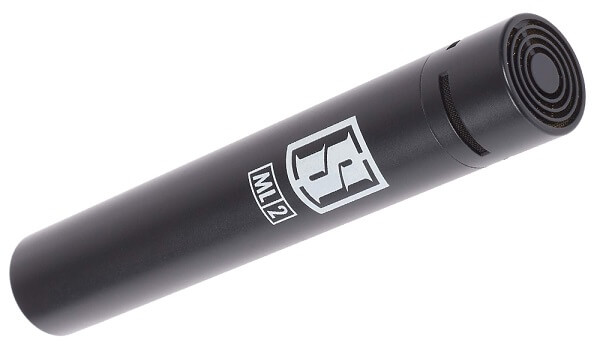
- Similar to the Slate Digital ML-1
- Includes licence for VMC Classic Instruments software
| IMAGE | PRODUCT | Amazon Store | For US Customers |
For EU Customers |
|---|---|---|---|---|
Slate Digital VMS ML-2 |
5. AKG P170 Small-diaphragm Condenser Microphone
The AKG P170 Instrumental Microphone is a half-inch small diaphragm condenser mic designed specifically for capturing instruments rather than vocals. As a condenser microphone, it delivers high sound quality, but it also requires a power source—either batteries or, more commonly, phantom power. In the case of the AKG P170, you’ll need a phantom power supply.
The design of the AKG P170 closely follows that of the older, now-discontinued AKG 170 Instrumental Microphone. One of the biggest differences is the size and shape of the capsule vent. While this might seem like a minor detail, it actually has a real impact on the microphone’s high-frequency response—even though both models have similar response graphs.
The AKG P170 is built for handling overheads, acoustic guitars, and other string instruments, thanks to its half-inch true condenser transducer diaphragm. This design allows it to pick up sound with excellent clarity and fast transient response.
Like most condenser mics, the AKG P170 is compact. Measuring 160 mm (6.3 inches) in length, 22 mm (0.9 inches) in diameter, and weighing just 130 g (4.6 ounces), it fits right in with the typical size and weight of other condenser microphones.
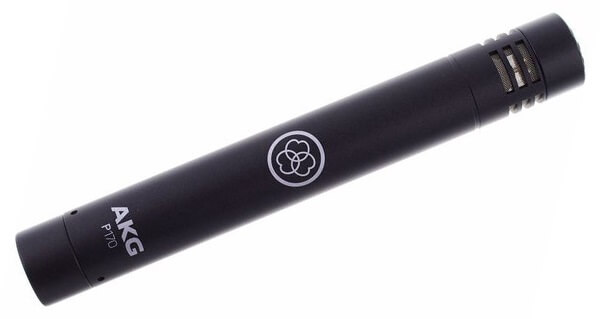
- Cardioid
- Frequency range: 20 – 20,000 Hz
- Impedance: 200 Ohm
- Switchable pad: -20
| IMAGE | PRODUCT | Amazon Store | For US Customers |
For EU Customers |
|---|---|---|---|---|
AKG P170 |
6. Neumann KM 184 Cardioid Small-diaphragm Condenser Microphone
The Neumann KM 184 is a pencil condenser microphone with a single, cardioid polar pattern. It uses a transformerless FET design, which means there’s no added coloration—so the mic delivers a clear sound and can handle a wide range of volumes without distortion.
This is great news for many musicians, since other microphones can struggle with distortion, especially when overloaded. Weighing just 80g, it’s lightweight and portable, making it ideal for a variety of uses, including taking it on the road.
Like all of Neumann’s microphones, the KM 184 is carefully and meticulously engineered to deliver the best sound possible. Its cardioid pattern is frequency-independent, which allows for excellent rejection of unwanted sound.
The frequency response is smooth, and the microphone has a low self-noise of just 13 dBA, while still being able to handle sound pressure levels up to 138 dB. Overall, it’s designed to give you the best sound possible, whether you’re on stage or in the studio.
The Neumann KM 184 was first released in 1993. It was developed to replace the classic Neumann KM 84 in the company’s updated product lineup. Thanks to its high performance—especially with vocal mics—Neumann has built an almost legendary reputation.
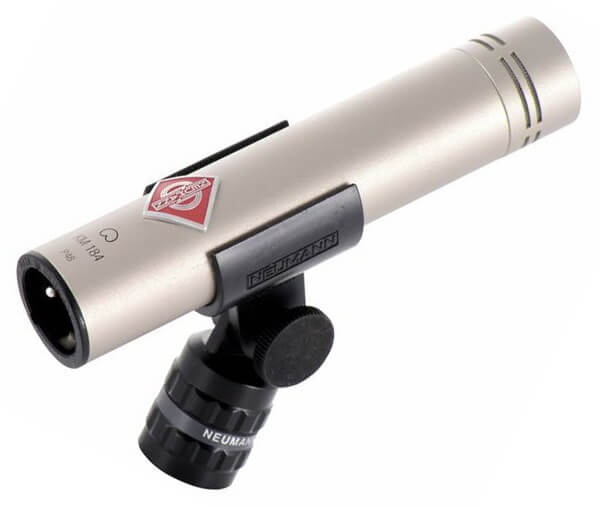
- Polar pattern: cardioid
- Frequency response: 20-20000 Hz
- Nominal Impedance: 50 Ohm
- Pressure gradient transducer
| IMAGE | PRODUCT | Amazon Store | For US Customers |
For EU Customers |
|---|---|---|---|---|
Neumann KM 184 |
7. Warm Audio WA-84 Small-diaphragm Condenser Microphone
The Warm Audio WA-84 is a small-diaphragm, phantom-powered cardioid condenser microphone inspired by the long-discontinued Neumann KM-84. This pencil-style condenser mic measures 131 mm in length and 22 mm in diameter (5.16″ x 0.87″), and weighs just 122 grams (4.3 ounces).
The WA-84 features a distinctive design with its capsule housed in a removable head that can be unscrewed and detached from the body containing the electronics. The body closely resembles the classic KM-84, including the similarly sized and shaped vents behind the removable capsule.
Designed for professional studios, home studios, live performances, and broadcast applications, the WA-84 delivers excellent sound on a wide range of instruments and sources. It works well with acoustic and electric guitars, acoustic and electric bass, drums, piano, strings, brass and woodwind instruments, and many other sources.
The WA-84 includes a -10 dB pad switch on the side of the body. The switch is slightly recessed to prevent accidental activation—you’ll need a small screwdriver, toothpick, or the tip of a pen to move it. The pad is placed directly after the capsule, before the rest of the mic’s electronics, which keeps the signal from the capsule from overloading the onboard amplifier.
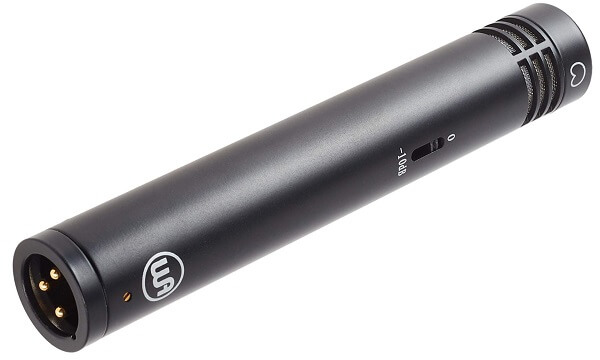
- Polar pattern: cardioid
- Frequency response: 20-20000 Hz
- Dynamic range: 107 dB(a)
- Signal-to-noise ratio: 78 dB(a)
| IMAGE | PRODUCT | Amazon Store | For US Customers |
For EU Customers |
|---|---|---|---|---|
Warm Audio WA-84 |
8. Telefunken M62 FET Hypercardioid Small-diaphragm Condenser
The Telefunken M62 is a small-diaphragm, hyper-cardioid FET condenser microphone designed to deliver quick transient response and accurate, yet musical frequency reproduction for musicians and recording engineers in professional studios.
The M60 FET body features a custom-wound transformer, an active FET transistor, and a Class-A discrete amplifier. The included TK62 capsule uses a 6-micron, gold-sputtered membrane and offers a hyper-cardioid polar pattern.
This combination provides a surprisingly full low end and a fast, accurate transient response. The TK62 is flat in response from 150 Hz to 3 kHz, with a slight dip at 6 kHz and a clear, airy presence peak at 8 kHz. This tightened polar pattern makes it ideal for cymbals, percussion, and as a stereo pair for live performance recording.
Thanks to a proprietary circuit design, this reimagined FET mic amplifier delivers exceptional transient response and high SPL capability. Carefully selected and tested components are hand-placed into gold-plated circuit board traces, resulting in an ultra-clean true Class-A discrete amplifier with a frequency response of ±2 dB from 20 Hz to 50 kHz.
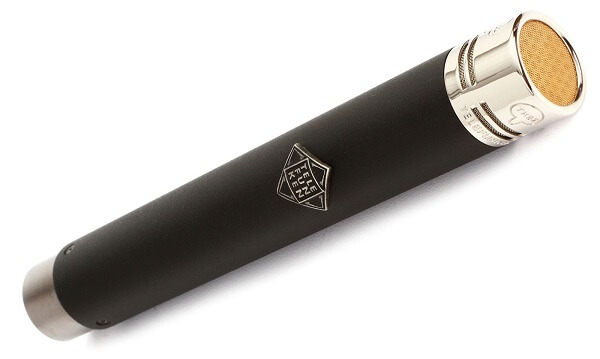
- Polar pattern: hyper-cardioid capsule
- Frequency response: 20-20000 Hz
- Ships with shockmount and XLR cable
- Slight dip at 6kHz and peak at 8kHz
| IMAGE | PRODUCT | Amazon Store | For US Customers |
|---|---|---|---|
Telefunken M62 FET |
9. Audio-Technica PRO 37 Small-diaphragm Condenser Microphone
The PRO 37 has made a name for itself as a versatile choice for both studio recording and live performance. With its low-mass components for excellent transient response and a low-profile design for easy mic placement, this mic shines when handling high sound pressure levels.
The PRO 37 is a truly helpful and unique small-diaphragm condenser. What’s cool is that it has its own character—a kind of interesting grittiness that’s hard to match with other mics in its class. The frequency response features a big presence boost, though it drops off sharply around 15 kHz.
In classic Audio-Technica fashion, the PRO 37 is straightforward and simple in its design, with a sturdy, all-black, all-metal body that’s just under 4 inches long. Not only is it tough enough to handle the usual wear and tear of studio use, but it’s also lightweight, which makes it easier to use with tricky mic stand setups.
The PRO 37 stands out when it comes to performance. As you might expect from a compact overhead mic, it’s not the best choice for recording vocals—it’s possible, but this mic is most comfortable recording instruments, from electric guitars to punchy drums.
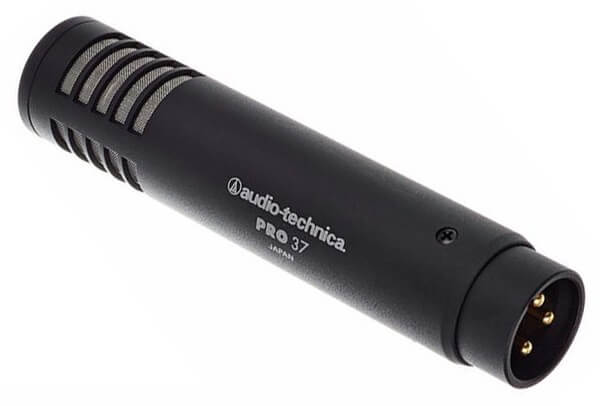
- Polar pattern: cardioid capsule
- Frequency response: 30 – 15,000 Hz
- Impedance: 200 Ohm
- 141 dB SPL, 1 kHz, at 1% T.H.D.
| IMAGE | PRODUCT | Amazon Store | For US Customers |
For EU Customers |
|---|---|---|---|---|
Audio-Technica PRO 37 |
10. Shure SM81 Small-diaphragm Condenser Microphone
The SM81 is the perfect choice for expert musicians or sound engineers looking to mic up acoustic instruments like acoustic guitar, piano, and cymbals. It works just as well on stage as it does in the studio, thanks to its top-notch quality and reliability.
The SM81 features a flat response curve, ensuring an accurate reproduction of your sound source, and it also includes a bass roll-off switch for added flexibility. With a lockable 0dB/10dB attenuator switch, you can easily handle louder sound sources. Its cardioid polar pattern focuses on the main sound while minimizing unwanted noise.
The Shure SM81 is a high-quality condenser microphone with a cardioid pickup pattern, designed for studio recording, broadcasting, television, and live sound. Its linear response, wide frequency range, low self-noise, and low sensitivity to high-frequency noise have made the SM81 a standard choice for recording acoustic instruments such as guitar, piano, and drums.
If you’re looking for a truly accurate microphone, the SM81 will not disappoint. Its clear and transparent sound, rugged construction, and flat 20Hz–20kHz frequency response have earned it a reputation for delivering a neutral and natural tone.
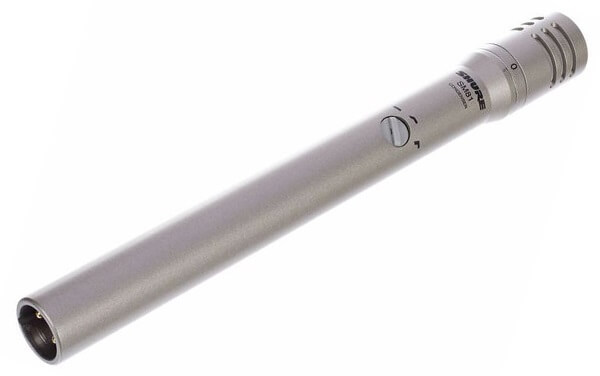
- Switchable 10 dB attenuation
- Frequency range: 20 Hz / 20 kHz
- Low sensitivity to interference at high-frequencies
- Robust steel version
| IMAGE | PRODUCT | Amazon Store | For All Customers |
|---|---|---|---|
Shure SM81 |
Conclusion
The perfect small-diaphragm condenser microphones really bring us into a specific niche of mics to evaluate. As we’ve seen, microphones come in all shapes, sizes, styles, and personalities. Today, we’re looking at some great options for recording and performing with those shiny and sharp overtones.
A small diaphragm is usually about half an inch in diameter. These mics are great for both recording and live use. They are especially suited for capturing high-frequency sounds and those that change volume quickly, like cymbals. Just like other condenser mics, small diaphragm microphones need either a battery or phantom power to operate.
Small-diaphragm condenser microphones are valuable tools in both studio and live sound environments around the world. They’re often used for close-miking instruments and as distant or room mics. Their fast transient response, extended frequency range, and consistent polar pattern make them a top choice for many situations where precision is important.
We believe we’ve provided you with a solid selection of the Top 10 small-diaphragm microphones to consider. If you have any questions about this topic, please let us know in the comment section below.

